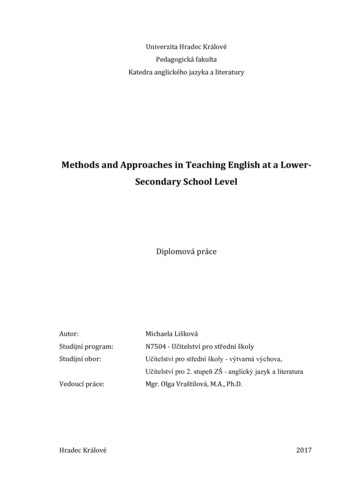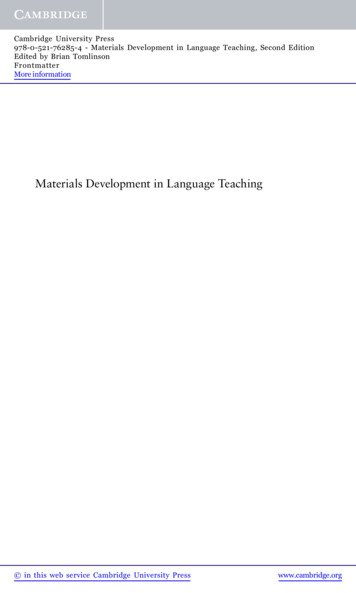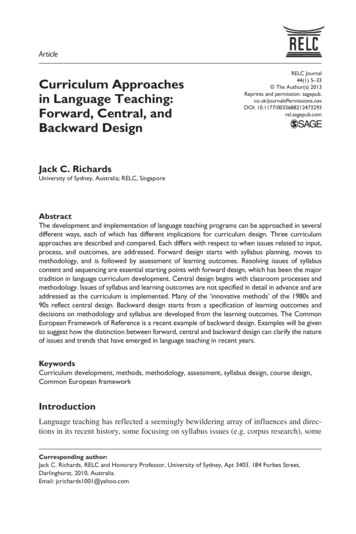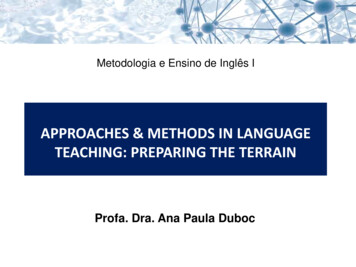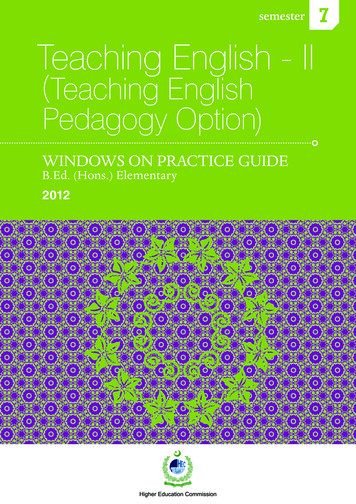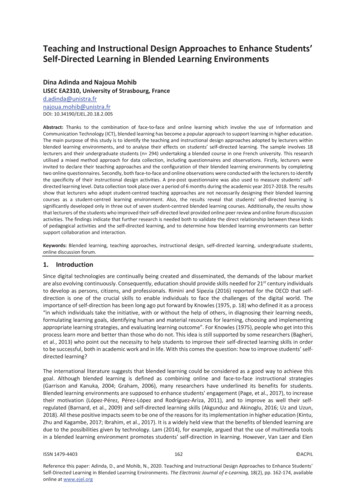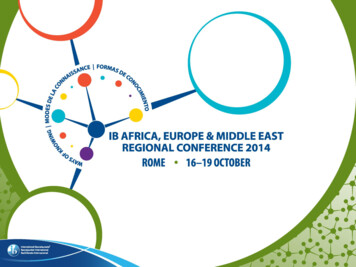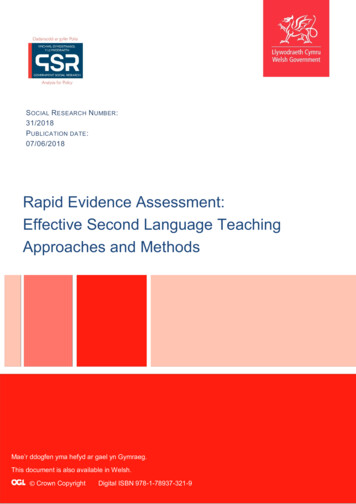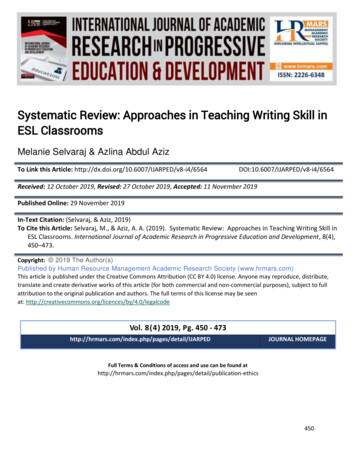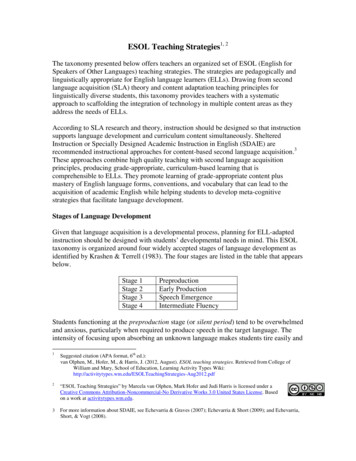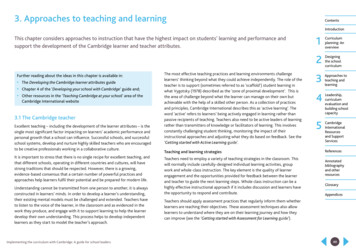
Transcription
3. Approaches to teaching and learningContentsIntroductionThis chapter considers approaches to instruction that have the highest impact on students’ learning and performance andsupport the development of the Cambridge learner and teacher attributes.Further reading about the ideas in this chapter is available in: The Developing the Cambridge learner attributes guide Chapter 4 of the ‘Developing your school with Cambridge’ guide and; Other resources in the ‘Teaching Cambridge at your school’ area of theCambridge International website3.1 The Cambridge teacherExcellent teaching – including the development of the learner attributes – is thesingle most significant factor impacting on learners’ academic performance andpersonal growth that a school can influence. Successful schools, and successfulschool systems, develop and nurture highly skilled teachers who are encouragedto be creative professionals working in a collaborative culture.It is important to stress that there is no single recipe for excellent teaching, andthat different schools, operating in different countries and cultures, will havestrong traditions that should be respected. However, there is a growing,evidence-based consensus that a certain number of powerful practices andapproaches help learners fulfil their potential and be prepared for modern life.Understanding cannot be transmitted from one person to another; it is alwaysconstructed in learners’ minds. In order to develop a learner’s understanding,their existing mental models must be challenged and extended. Teachers haveto listen to the voice of the learner, in the classroom and as evidenced in thework they produce, and engage with it to support learning to help the learnerdevelop their own understanding. This process helps to develop independentlearners as they start to model the teacher’s approach.Implementing the curriculum with Cambridge: A guide for school leadersThe most effective teaching practices and learning environments challengelearners’ thinking beyond what they could achieve independently. The role of theteacher is to support (sometimes referred to as ‘scaffold’) student learning inwhat Vygotsky (1978) described as the ‘zone of proximal development’. This isthe area of challenge beyond what the learner can manage on their own butachievable with the help of a skilled other person. As a collection of practicesand principles, Cambridge International describes this as ‘active learning’. Theword ‘active’ refers to learners’ being actively engaged in learning rather thanpassive recipients of teaching. Teachers also need to be active leaders of learningrather than transmitters of knowledge or facilitators of learning. This involvesconstantly challenging student thinking, monitoring the impact of theirinstructional approaches and adjusting what they do based on feedback. See the‘Getting started with Active Learning guide’.Teaching and learning strategiesTeachers need to employ a variety of teaching strategies in the classroom. Thiswill normally include carefully-designed individual learning activities, groupwork and whole-class instruction. The key element is the quality of learnerengagement and the opportunities provided for feedback between the learnerand teacher to guide the next learning steps. Whole class instruction can be ahighly effective instructional approach if it includes discussion and learners havethe opportunity to respond and contribute.1Curriculumplanning: Anoverview2Designingthe schoolcurriculum3Approaches toteaching andlearning4Leadership,curriculumevaluation andbuilding schoolcapacity5CambridgeInternationalResourcesand SupportServicesReferencesAnnotatedbibliographyand otherresourcesGlossaryAppendicesTeachers should apply assessment practices that regularly inform them whetherlearners are reaching their objectives. These assessment techniques also allowlearners to understand where they are on their learning journey and how theycan improve (see the ‘Getting started with Assessment for Learning guide’).40
3. Approaches to teaching and learningContentsIntroductionTeachers as role modelsOutstanding teachers model the Cambridge learner attributes. They areconfident, responsible, reflective, innovative and engaged because they: Have mastery of their subject area. They can relate concepts and skills insuch a way that students learn to understand and appreciate the nature ofthe academic discipline they are studying, and what constitutes excellence forthe developmental stage they are teaching. Teach for understanding as well as coverage. They have the ability to engagewith learners’ mental ideas about the really important concepts, and takethem on a journey of discovery. This approach requires learners to revisitconcepts over an extended period of time and within different contexts. Thisspiralling strategy reinforces learning and leads to deeper levels ofunderstanding. Connect learning to the real world. They connect learning to other topics inthe subject, other disciplines and the experience of learners – making learningrelevant. Scaffold learning. Teachers need to constantly challenge student thinking inthe proximal zone of development. The optimal level of performance for alearner is the level that they can reach when they receive expert support, asdistinct from the functional level, which they can achieve independently.Scaffolding learning helps to close this gap. Have a learning rather than a performance orientation. Chris Watkins (2010)points out that too many schools and teachers are more concerned aboutstudents looking good rather than learning well. There is considerableevidence that learning to learn is an effective strategy at raising studentperformance and preparing them to be independent, self-regulated learnersequipped for modern life. Are able to model problem solving and consider themselves as mentors asmuch as teachers. They are concerned with the holistic development of thelearner and understand the critical role that attitudes, emotions and self-Implementing the curriculum with Cambridge: A guide for school leadersconfidence play in learning. They communicate a love of learning and believeevery learner can achieve. Understand, and can apply, assessment for different purposes. They have anexcellent grasp of summative assessment practices, but they also understandhow to use assessment to support student learning. This is the process ofidentifying what the learner has or has not achieved in order to plan the nextsteps in learning and provide appropriate support. Use a variety of different teaching strategies and activities. This includeswhole class instruction, collaborative group work and creative assignmentsand activities, as well as overseeing individual learning. Are reflective and creative practitioners engaged in ongoing effectiveprofessional learning. Are collaborative and supportive of their colleagues, the school and theschool’s community.In order to support schools, Cambridge has developed a set of teacher standardswhich define the key professional characteristics and practices that teachersshould develop to enable effective student learning in Cambridge schools. Thestandards can help to provide benchmarks against which teachers and theirschools can evaluate their current practice and plan future development. Theycan show how the Cambridge Teacher and Cambridge Leader attributes aredemonstrated in practice and they can contribute to the development of ashared frame of reference within which schools can work to improve the qualityof teaching and leadership. The standards are flexible and have been developedso that they can be used to best effect in each school context providing abenchmark of what Cambridge considers to be teacher quality. See here:3.2 The Cambridge learner and teacher attributes1Curriculumplanning: Anoverview2Designingthe schoolcurriculum3Approaches toteaching andlearning4Leadership,curriculumevaluation andbuilding schoolcapacity5CambridgeInternationalResourcesand SupportServicesReferencesAnnotatedbibliographyand otherresourcesGlossaryAppendicesSchools want their learners to combine both a deep understanding of their ownculture and nation, with the skills to be global learners who are able tocontribute and adapt to the uncertainties of the modern world. Cambridgeintroduced the learner/teacher attributes (Table 8), which recognise that a41
3. Approaches to teaching and learningContentsIntroductionmeaningful curriculum is more than a collection of different subjects. Learnersneed to develop the academic abilities, life skills and attitudes needed to besuccessful in higher education and in the world of work.The purpose of the Cambridge learner and teacher attributes is to support thedevelopment of five powerful and highly desirable learning habits that willinspire students to love learning and help them to lead fulfilled and successfullives. Students who demonstrate the attributes habitually and skilfully employ abroad range of cognitive skills and socio-emotional skills (including personalityqualities such as resilience, self-motivation and self-regulation) towardseffectively managing their performance.Table 8: Learner and teacher attributesConfidentCambridge learnersCambridge teachersConfident in working with information and ideas – their own and those of others.Cambridge learners are confident, secure in their knowledge, unwilling to take thingsfor granted and ready to take intellectual risks. They are keen to explore and evaluateideas and arguments in a structured, critical and analytical way. They are able tocommunicate and defend views and opinions as well as respect those of others.Confident in teaching their subject and engaging each student in learning.Cambridge teachers know their subject well and know how to teach it. They seek tounderstand their students and their educational needs. They strive to communicatea love of learning and to encourage students to engage actively in their ownlearning.ResponsibleResponsible for themselves, responsive to and respectful of others.Cambridge learners take ownership of their learning, set targets and insist onintellectual integrity. They are collaborative and supportive. They understand thattheir actions have impacts on others and on the environment. They appreciate theimportance of culture, context and community.ReflectiveReflective as learners, developing their ability to learn.Cambridge learners understand themselves as learners. They are concerned with theprocesses as well as the products of their learning and develop the awareness andstrategies to be life-long learners.Reflective as learners themselves, developing their practice.Cambridge teachers are themselves learners, seeking to build on and develop theirknowledge and skills through a virtuous circle of reflection on practice – involvingresearch, evaluation and adaptation. They support students to become independentand reflective learners.Innovative and equipped for new and future challenges.Cambridge learners welcome new challenges and meet them resourcefully,creatively and imaginatively. They are capable of applying their knowledge andunderstanding to solve new and unfamiliar problems. They can adapt flexibly to newsituations requiring new ways of thinkingInnovative and equipped for new and future challenges.Cambridge teachers are creative, experimenting with new ideas and pursuingan enquiring approach in their teaching. They are open to new challenges, beingresourceful, imaginative, and flexible. They are always ready to learn and apply newskills and techniques.Innovative and equipped for new and future challenges.Cambridge teachers are creative, experimenting with new ideas and pursuingan enquiring approach in their teaching. They are open to new challenges, beingresourceful, imaginative, and flexible. They are always ready to learn and apply newskills and techniques.Engaged intellectually, professionally and socially, ready to make a difference.Cambridge teachers are passionate about learning within and beyond theclassroom, sharing their knowledge and skills with teachers in the wider educationalcommunity.InnovativeEngagedImplementing the curriculum with Cambridge: A guide for school leadersResponsible for themselves, responsive to and respectful of others.Cambridge teachers are highly professional in their approach to teaching, and theyare collaborative and supportive. They understand that their actions will help shapefuture generations and they are concerned about the holistic development of everyindividual they teach.1Curriculumplanning: Anoverview2Designingthe schoolcurriculum3Approaches toteaching andlearning4Leadership,curriculumevaluation andbuilding schoolcapacity5CambridgeInternationalResourcesand SupportServicesReferencesAnnotatedbibliographyand otherresourcesGlossaryAppendices42
3. Approaches to teaching and learningContentsIntroductionThese attributes are not intended to be exhaustive. Schools may want tosupplement them with others derived from the school’s vision. To make thelearner attributes more meaningful, school leaders should actively engage theschool community with them, helping people understand why they matter andhow they fit in with the school mission.Subject curricula are more than subsets of knowledge to be taught and assessedby teachers and learned by students. They are the basis for the teaching andlearning programmes that teachers use to express and deliver their widerexpectations of learners. When planning lessons, teachers can build inopportunities for students to participate in learning activities and events thathelp grow and advance the development of learner attributes – consistent withthe active learning approach described in the previous section.The learner attributes apply across the curriculum and need to be supportedboth through the school’s curriculum and co-curricular programmes.Implementing the curriculum with Cambridge: A guide for school leadersWhen designing the school curriculum, it is important to ensure a breadth andbalance of subjects and educational activities that contribute to cognitive,creative and psychomotor development. Some subjects lend themselvesparticularly well to collaborative work, creative expression and developinglearner research skills, whether individual or collaborative (for exampleCambridge Global Perspectives).1Curriculumplanning: Anoverview2Designingthe schoolcurriculumHaving a rich selection of co-curricular activities will provide learners withopportunities to develop the inter- and intra-personal skills described in theattributes.3Approaches toteaching andlearningThe school’s environment, culture and the unacknowledged learning thatpermeates the school community beyond the classroom, will also have animportant role in nurturing these attributes. Hence, the whole schoolcommunity needs to be engaged with them.4Leadership,curriculumevaluation andbuilding schoolcapacityIn every school there will be some discrepancy between planned learningoutcomes and the experience learners actually receive. It is extremely importantto monitor and evaluate the experienced curriculum to see if what learnersactually experience corresponds to what was intended. School evaluationprocedures involving learners, teachers and parents can provide insightfulfeedback (see Chapter 4).5Becoming a reflective learner also requires beingconfident, responsible, innovative and engaged.3.3 Becoming a reflective learnerThe reflective attribute highlights the importance of learners understandingthemselves as learners. This requires them to constantly reflect on their learningand accurately judge their own progress. They are able to employ a range ofstrategies to overcome the learning challenges they will inevitably face.Becoming a reflective learner also requires being confident, responsible,innovative and engaged. All of the learner attributes are interconnected.CambridgeInternationalResourcesand SupportServicesReferencesAnnotatedbibliographyand otherresourcesGlossaryAppendices43
3. Approaches to teaching and learningContentsIntroductionReflective learners: are effective at planning and managing their work and performance andaccurately evaluating their progress understand themselves as learners and the nature of the knowledge they arelearning apply their understanding to performance, constantly monitor what they aredoing and produce appropriate responses are able to think both critically and creatively so as to overcome barriers tolearning and engage with subject content deeply learn from mistakes and see failure as a learning opportunity are emotionally resilient when confronted with setbacks are confident, but not arrogant, in working with others and sharing ideas care about the learning of others and realise that learning is social andcollective.While most schools would agree that learning how to become a reflectivelearner is critical, many assume that learners will develop these skillsindependently and so it is not considered as part of the curriculum.All teachers should prioritise and understand their role in helping students tolearn how to learn. Some schools have tried to teach learning/reflective/studyskills as an extra course. Separate classes tend not to be very successful becauselearning strategies and reflective practice are best developed in the context ofthe learning students experience in their classes.Effective learners understand that learning is an active process involvingquestioning, discovery of barriers, devising strategies to overcome the barriers,constantly evaluating progress and changing what they do if it does not work.Less effective learners often take a passive approach. When trying to revise, forexample, they read and re-read books and their notes, trying to absorb thematerial. This is based on the false premise that understanding can betransmitted from a text (or a person) to the memory.Implementing the curriculum with Cambridge: A guide for school leadersActive learning has to be deliberately practised in different contexts, andsupported by the school and individual teachers who understand and model thepractices themselves. This will not happen unless it is emphasised as acurriculum competence and supported by structures and systems thatemphasise: clearly identifying learning aims and objectives in each subject the development of concepts (and therefore language) that help individualsunderstand and describe the learning process they are going through emphasising a holistic understanding of each academic discipline, buildingbridges between what is learned in one context and in another ongoing professional development for teachers and the creation ofprofessional learning communities that support teaching practice.Reflection and learning to learn are considered in more detail in chapter 3 of the‘Developing the Learner Attributes’ guide.3.4 Disciplinary and inter-disciplinary approachesSchools usually, and for good reason, design the school curriculum around theprovision of a balance of different subjects appropriate for each age group.However, there are many areas of overlap between subjects. The schoolcurriculum should therefore enable students to develop a holistic understandingof themselves as learners, and to reflect on the similarities and differencesbetween different subject approaches.The main reason for including academic disciplines in the curriculum is that theynurture the ability to think critically and solve problems with applications thatare not easily acquired from everyday experience. Michael Young describes thisas ‘powerful knowledge’ (see Young, 2013). The humanities, social sciences,science, mathematics, languages and the arts - when well taught andappropriately assessed - all develop the ability to think critically and creatively.They do this in ways that are not easily transferable to other contexts.1Curriculumplanning: Anoverview2Designingthe schoolcurriculum3Approaches toteaching andlearning4Leadership,curriculumevaluation andbuilding schoolcapacity5CambridgeInternationalResourcesand SupportServicesReferencesAnnotatedbibliographyand otherresourcesGlossaryAppendicesIn order for students to become effective critical and creative thinkers ineveryday life, they need to be able to reflect on and apply approaches they learn44
3. Approaches to teaching and learningContentsIntroductionin academic disciplines in an interdisciplinary way. Interdisciplinaryunderstanding is extremely important. It refers to the ability - and confidence to navigate between disciplines, make connections and develop a holisticappreciation of knowledge that provides new perspectives.Disciplinary understanding needs to be the foundation on which a rigorousinterdisciplinary approach is based. Without this foundation, learning can lead tosuperficial coverage and confusion. Teachers, backed by a supportive curriculum,can help make connections in students’ minds between what they learn in onecontext and another.Excellent schools support the development of interdisciplinary understanding byexpecting teachers to plan collaboratively. Teachers need to understand whattheir colleagues are teaching to a particular year group in order to makeconnections with their own classes. Some schools identify interdisciplinary linksin the curriculum. This may be done in an informal way with individual teacherssharing their teaching plans in the staff room, or during meetings scheduled forthis purpose. One simple example of this would be where students have learnedsome statistical skills in mathematics, and the geography teacher makes themapply this knowledge to their geography coursework, thereby reinforcing theconcepts.Another way of reinforcing interdisciplinary links is to have curriculumcoordinators examining the learning across particular age groups, helping toidentify and support meaningful connections. This complements the work ofheads of department, who oversee coherence and consistency within a verticalsubject curriculum.Curriculum planning is very important when it comes to choosing the activities,courses and qualifications that will enable learners to draw on their experiencesacross the curriculum in order to think in interdisciplinary ways. Learners need tobe challenged, required to produce extended project work and makepresentations on their findings, working collectively and individually on differentassignments. This is the approach adopted in Cambridge Global Perspectives.Implementing the curriculum with Cambridge: A guide for school leadersCambridge Global PerspectivesCambridge Global Perspectives is an interdisciplinary programme, offered atCambridge Primary, Lower Secondary, IGCSE, AS & A Level.Cambridge Global Perspectives focuses on the nature of argument and evidence,encourages understanding and respect for the perspectives of others, anddevelops a range of skills needed for success in higher education and the worldof work in the 21st century.Students learn to appreciate a variety of alternative perspectives on globalissues where ideas and interests compete and there are no easy answers. Theylearn how to evaluate different arguments, in particular the evidence andreasoning used to support them, as well as to improve the quality of their ownarguments. These important skills are transferable to learners’ other subjects.Through studying global topics, learners gain an international context in whichthey can develop their skills. Students develop flexible, reflective, creative andcritical thinking. They learn how to research issues, arriving at well-reasoned andevidence-based conclusions. Students also learn to work collaboratively withothers and effectively communicate and critique ideas so that they becomemore confident, responsible, reflective, innovative and engaged.Cambridge Global Perspectives can be taught as a stand-alone subject.However, schools can also opt to use Cambridge Global Perspectives as thecurriculum core. This places it at the heart of the school curriculum andemphasises its interdisciplinary nature. Teachers of other subjects would bemade aware of its learning and assessment objectives and, where applicable,support them in the teaching of their own subject. Learner research and projectwork would be coordinated, with subject-expert teachers acting as mentorsacross the curriculum.1Curriculumplanning: Anoverview2Designingthe schoolcurriculum3Approaches toteaching andlearning4Leadership,curriculumevaluation andbuilding schoolcapacity5CambridgeInternationalResourcesand SupportServicesReferencesAnnotatedbibliographyand otherresourcesGlossaryAppendices3.5 Using conceptual frameworks to support learningConcepts are a way of categorising things to make sense of a complex anddiverse world. Through this grouping we create a shared framework forunderstanding, communication and action. Each school subject involves a largenumber of concepts. Substantive concepts are part of the substance or content45
3. Approaches to teaching and learningContentsIntroductionknowledge in a subject, for example in geography these might include ‘river’,‘trade’, ‘city’ or ‘ecosystem’. Second-order concepts shape the key questionsasked in a subject and organise the subject knowledge, for example secondorder concepts in history might include ‘cause and consequence’, ‘change andcontinuity’, ‘similarity and difference’ and ‘historical significance’. There willoften be an overlap of substantive concepts between subjects. A student mightlearn about ‘renewable energy’ in science, geography, economics and politics.There may even be some overlap of second-order concepts, for example ‘change’in both history and geography. It is the particular combination of substantiveand second-order concepts that makes each discipline distinct and unique.A threshold concept is one that, once understood, modifies learners’understanding of a particular field and helps them to make progress to the nextlevel. It helps them to go through a ‘doorway’ into a new way of understanding atopic or subject (Meyer and Land, 2003).Part of effective teaching, supported by effective curriculum and assessmentplanning, is identifying which concepts are most important or ‘key’ for aparticular developmental stage of learning. Cambridge syllabuses help scaffoldlearning through identifying important concepts. However, teachers need toadapt these to their own circumstances and incorporate them into their lessonplanning and instructional design. Thinking carefully about key concepts canhelp teachers and heads of Department to better understand their subjectdiscipline, and to support their learners ’progress.Key concepts help create an understanding of the structure of a discipline,providing opportunities to link, review and put knowledge into context. Thishelps learners to progress, as well as to think and behave as a skilledmathematician, historian, chemist etc. A key concept will often link one topic toanother, for example in economics, the concept of ‘opportunity cost’ links otherareas of the curriculum such as production possibility frontier and the theory ofcomparative advantage.For more guidance see the ‘Getting started with Key Concepts’ guide.1Curriculumplanning: Anoverview2Designingthe schoolcurriculum3Approaches toteaching andlearning4Leadership,curriculumevaluation andbuilding schoolcapacity5CambridgeInternationalResourcesand SupportServices3.6 CollaborationReferencesStudents need to learn to function effectively as team members and leaders, asthis is an important ability in life and the workplace. They also need to learn tosolve problems collaboratively. The Organisation for Economic Co-operationand Development (OECD, 2013, p. 6) defines collaboration as follows:Annotatedbibliographyand otherresources‘Collaborative problem-solving competency is the capacity of an individual toeffectively engage in a process whereby two or more agents attempt to solve aproblem by sharing the understanding and effort required to come to a solution andpooling their knowledge, skills and efforts to reach that solution.’GlossaryAppendicesCollaborative problem-solving requires teamwork where individuals actively,responsibly and productively work towards a shared goal. Individualresponsibilities may change as progress or obstacles are met. The skills requiredto be an effective collaborator are different from those required to be a goodImplementing the curriculum with Cambridge: A guide for school leaders46
3. Approaches to teaching and learningContentsIntroductionindividual learner. Students need to be able to define the problem and ensurethey have a joint understanding of what is being asked, think critically as agroup, communicate and reflect on how well the group is progressing towardssolving the problem. Collaboration is not the same as cooperation and thisdistinction needs to be understood by teachers planning group work.Schools that focus on the learner attributes have a responsibility to provideopportunities for collaborative learning through well-planned learning activities.Many academic disciplines can provide such learning opportunities throughcollaboration, including social science fieldwork and science practicals, orproject work in courses like Cambridge Global Perspectives and enterprise. Theco-curricular programme provides opportunities for group work and collaboration.3.7 Information literacy and using information &communications technology [ICT] in the classroomEffectively using ICT resources is another essential skill all learners need todevelop. Over the past decade, the use of digital technologies in classrooms hascontinued to expand. Desktops, laptops, tablets and smart phones arecommonly used for learning, as educators find ways to employ today’stechnologies in school classrooms across all subjects. Including ICT-basedresources and activities in teaching programmes can be challenging, but it isvital for today’s generation of learners as they use ICT resources to access,process, evaluate and
Approaches to teaching and learning meaningful curriculum is more than a collection of different subjects. Learners need to develop the academic abilities, life skills and attitudes needed to be
